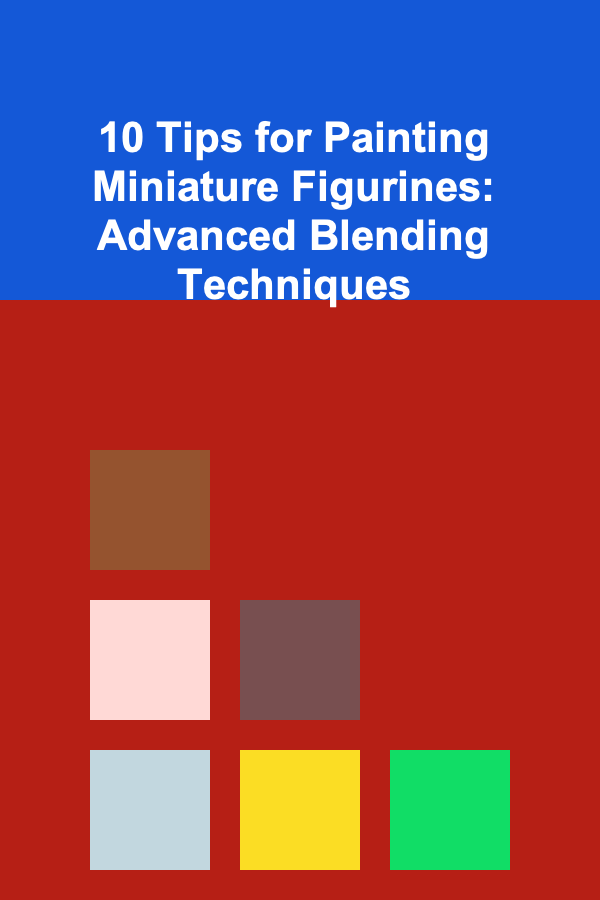
10 Tips for Painting Miniature Figurines: Advanced Blending Techniques
ebook include PDF & Audio bundle (Micro Guide)
$12.99$8.99
Limited Time Offer! Order within the next:

Painting miniature figurines is both an art and a science, requiring precision, patience, and an understanding of various painting techniques. For hobbyists and professional painters alike, mastering advanced blending techniques is crucial for achieving smooth transitions between colors, creating depth and dimension, and bringing the figurine to life. Whether you're working on miniatures for tabletop games, dioramas, or display models, advanced blending is a skill that can elevate your work to the next level.
In this article, we will explore ten advanced blending techniques that will help you refine your miniature painting process and achieve more realistic and visually stunning results. These tips will cover everything from brush control to glazing techniques, ensuring that you have a well-rounded approach to blending.
Use the Wet Blending Technique for Smooth Transitions
Wet blending is one of the most powerful techniques for creating smooth transitions between colors. It involves blending wet paints directly on the miniature's surface before they dry. This technique allows you to merge different colors seamlessly, achieving soft gradients and transitions that mimic the way light falls on real objects.
How to Do Wet Blending:
- Start with a base layer of your chosen color.
- Mix the two colors you want to blend, applying the first color to the miniature and then immediately applying the second color next to it.
- Use a clean brush, slightly damp with water or medium, to gently blend the two colors where they meet, creating a smooth transition.
Wet blending is ideal for large surface areas, like skin, cloth, or armor, where you want to create subtle gradation of light and dark.
Pro Tip:
Keep your paints thin and wet throughout the process. Using a slow-drying medium or extender will help maintain the workability of your paints for a longer period.
Master the Use of Glazing for Depth and Richness
Glazing involves applying thin, transparent layers of paint over dry base coats to adjust the tone and create depth. It's a technique often used for shading, color correction, or adding a tint to a surface.
How to Glaze:
- Thin your paint with water or a glazing medium to achieve a transparent consistency.
- Apply the glaze in thin layers over areas where you want to add depth or shift the color.
- Let each glaze layer dry before applying the next, building up the color gradually.
This technique is perfect for refining shadows or highlights and is particularly effective for painting skin tones, cloth, and surfaces with complex light interactions.
Pro Tip:
Use glazes to fix mistakes or transition between two colors that don't blend naturally. A well-applied glaze can smooth out rough transitions and create a more unified overall look.
Use Layering for Precise Control Over Highlights and Shadows
Layering is a technique in which you apply multiple thin layers of paint to gradually build up highlights and shadows. This method is ideal for achieving a high level of control over the final result and is often used in combination with wet blending and glazing.
How to Layer:
- Start with a base color and gradually build up lighter or darker layers.
- Use a light touch with each successive layer, ensuring that the paint is thin enough to not obscure the underlying colors.
- Focus on the raised areas for highlights and recessed areas for shadows.
Layering is often used for detailed areas like faces, eyes, and intricate parts of armor or clothing.
Pro Tip:
For highlights, use a very thin layer of the lightest color to create a more subtle effect, and avoid creating harsh lines. Layering builds up texture while maintaining the smoothness of the surface.
Use Airbrushing for Smooth Transitions and Gradient Effects
Airbrushing is a technique that uses compressed air to apply paint in fine mist layers. It's ideal for achieving smooth gradients, blending multiple colors seamlessly, and quickly covering large surface areas.
How to Airbrush:
- Choose the right type of paint for airbrushing, usually thinner paints or those specifically designed for airbrush use.
- Start by applying a light layer of the base color across the miniature.
- Gradually build up lighter or darker tones with subtle shifts in color to create smooth transitions.
Airbrushing is perfect for large areas of a miniature, such as armor panels, wings, and backgrounds, where smooth gradients are desired.
Pro Tip:
Keep the airbrush distance consistent and adjust the pressure for more control over the paint flow. Practicing with an airbrush on test models before using it on your final piece will help you get the hang of it.
Dry Brushing for Texture and Highlighting
Dry brushing is a quick and effective way to add highlights to raised details, such as armor, scales, or cloth folds. This technique uses a minimal amount of paint, which is then brushed lightly over the surface to catch only the raised areas.
How to Dry Brush:
- Load your brush with a small amount of paint, then wipe off almost all of it on a paper towel or cloth, leaving just a trace of paint on the bristles.
- Lightly drag the brush over the raised edges or details of the miniature, allowing the paint to catch only the high points.
Dry brushing works well for highlighting textures and surface details without overloading the model with paint.
Pro Tip:
Use progressively lighter shades of the base color for dry brushing, starting with a mid-tone and finishing with a light highlight for more realistic results.
Using Contrast Paints for Dynamic Blending Effects
Contrast paints are specially formulated to provide both shading and highlighting in a single step. These paints are designed to pool in recesses while leaving raised areas highlighted, making them an excellent choice for quick and dynamic blending.
How to Use Contrast Paints:
- Apply a layer of contrast paint directly to the areas you wish to shade and highlight.
- Let the paint naturally pool in the recesses of the miniature to create shading, while the raised areas will be highlighted by the thinner application of paint.
- Use contrast paints to create depth quickly, especially for organic textures like skin, fur, or cloth.
Contrast paints can be used for quick tabletop-level models or for creating dynamic visual effects without spending a lot of time on the blending process.
Pro Tip:
Experiment with layering contrast paints over different base colors to see how the tones interact. Contrast paints can also be used as a base layer before further highlighting or detailing.
Mastering the Use of Shadows and Highlights for Realism
One of the key components of advanced blending is understanding how to manipulate light and shadow to create realistic effects. Knowing where the light source is coming from and how it affects your model can help guide your blending process.
How to Apply Shadows and Highlights:
- Start with your basic colors, and then apply darker tones in the areas where shadows would naturally fall (such as under the chin, beneath armor plates, or in the recesses of folds).
- Highlight the raised areas where light would naturally hit, such as the tops of muscles, tips of weapons, or the edges of armor.
Understanding where to place shadows and highlights will give your miniature a three-dimensional appearance and bring out the details more effectively.
Pro Tip:
Use glazes and thin layers to transition between shadows and highlights smoothly. Harsh transitions can make a model appear flat or unrealistic.
Using the "Zenithal Highlighting" Technique
Zenithal highlighting is a technique where you airbrush the miniature with a base coat followed by light highlights from a specific angle. This technique mimics how natural light interacts with an object, with the brightest highlights coming from above (the zenith) and the shadows falling below.
How to Use Zenithal Highlighting:
- Start by priming your miniature with a dark undercoat (usually black or dark grey).
- Lightly spray the miniature from above with a light-colored primer or paint (such as white or light grey) to simulate the light falling on the top surfaces.
- Optionally, you can further refine the highlights with an even lighter color from the same direction.
Zenithal highlighting helps establish light and shadow quickly, making it easier to blend colors and create realistic shading.
Pro Tip:
Zenithal highlighting is especially useful when working with large or highly detailed models, as it provides a good starting point for further painting and blending.
Enhancing Detail with Glaze Layering for Smooth Transitions
Glaze layering is similar to standard glazing but involves multiple layers of glazes applied to create more refined transitions between colors and highlights. This technique is excellent for achieving nuanced effects, such as skin tones, fabric folds, or even hair.
How to Apply Glaze Layering:
- Start with a solid base color, then apply thin layers of glaze to adjust the tone.
- Focus on gradually building up color and depth using multiple thin glazes, each adding more intensity or smoothness to the transitions.
Glaze layering is a more controlled approach to blending, allowing you to work slowly and carefully on smaller areas with delicate details.
Pro Tip:
Use a clean, slightly damp brush to smooth out any visible lines between glazes, ensuring an even application.
Practice Patience and Consistency
Advanced blending techniques require time, practice, and a steady hand. Whether you're wet blending, glazing, or airbrushing, consistency is key to achieving smooth, professional results.
How to Improve:
- Take your time and focus on one area at a time, especially when layering or blending.
- Don't rush through the process. Allow each layer to dry before applying the next to avoid muddling the colors.
- Regularly clean your brushes and use the right brush sizes for different areas of the miniature.
Pro Tip:
Regularly practice these techniques on test models or spare parts of a miniature before applying them to your final piece. This will help you perfect your approach and gain confidence in your skills.
By incorporating these advanced blending techniques into your miniature painting process, you can create more realistic, detailed, and visually dynamic models. Each technique offers a unique approach to blending, whether you're striving for smooth transitions, refined highlights, or deep shadows. As with any skill, practice is essential---so keep experimenting, refining your process, and enjoying the rewarding challenge of painting miniature figurines!
Reading More From Our Other Websites
- [Home Cleaning 101] How to Descale and Sanitize Your Coffee Maker Using Household Ingredients
- [Organization Tip 101] How to Use Clear Containers for Organized Storage
- [Personal Investment 101] How to Invest in Real Estate with Limited Capital
- [Home Budget 101] How to Budget for Home Security Without Sacrificing Your Financial Stability: Smart Home Budgeting Ideas
- [Organization Tip 101] How to Make Laundry Day More Efficient
- [Home Family Activity 101] How to Create a Family Game Room on a Budget
- [Star Gazing Tip 101] Best DIY Light‑Pollution Filters for Enhancing Visible Nebula Details in Urban Settings
- [Organization Tip 101] How to Organize Your Skincare Products for Easy Access
- [Personal Investment 101] How to Prepare for a Real Estate Market Downturn
- [Organization Tip 101] How to Declutter Your Mind Through Organization

How to Create a Weekly Workout Schedule That Keeps You Motivated
Read More
How to Organize Your Wardrobe with Minimal Closet Space
Read More
How to Style a Welcoming Entryway Table
Read More
What Is a One-Page Website and Why It's Perfect for Your Business
Read More
How to Handle Family Introductions in Dating
Read MoreRetirement Plan Fee Tracker: A Step-by-Step Guide
Read MoreOther Products

How to Create a Weekly Workout Schedule That Keeps You Motivated
Read More
How to Organize Your Wardrobe with Minimal Closet Space
Read More
How to Style a Welcoming Entryway Table
Read More
What Is a One-Page Website and Why It's Perfect for Your Business
Read More